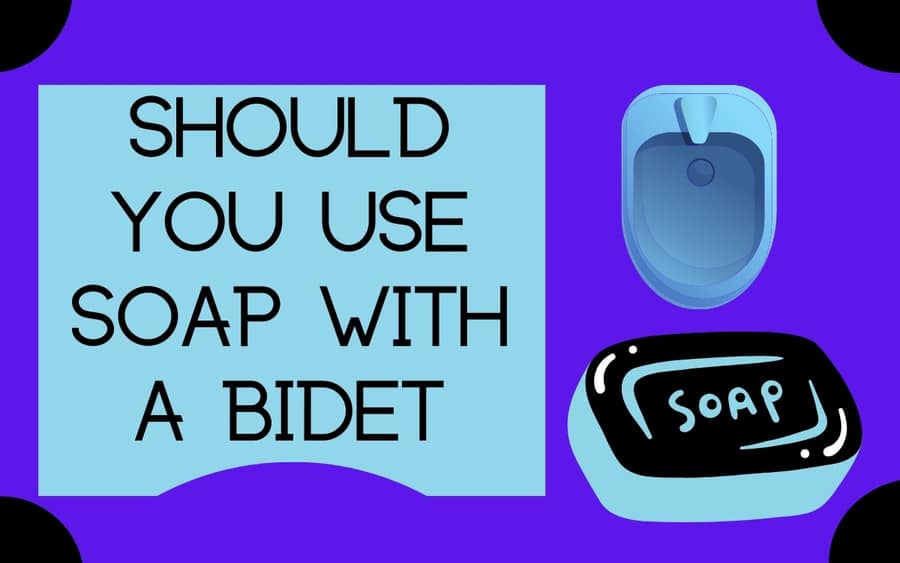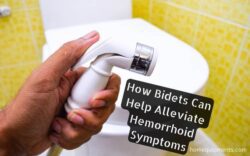Should you use soap with a bidet- Know the facts.

In this article, we will explore the question of whether or not to use soap with a bidet.
We will examine the benefits and risks of using soap, as well as the recommended types of soap for use with a bidet. We will also discuss the hygiene considerations involved in using a bidet with or without soap, so that you can make an informed decision about the best way to use your bidet.
While bidets are designed to clean the genital and anal areas, the question of whether or not to use soap with them is one that often arises. Some people believe that soap is necessary for thorough cleaning, while others believe that water alone is sufficient. Check out my article How do people dry themselves after using a bidet?
How to use a bidet
Bidets have been used for centuries as a way to promote personal hygiene and cleanliness, particularly in parts of the world such as Europe, Asia, and the Middle East. In recent years, bidets have gained popularity in the United States, as people become more aware of their benefits.
One of the primary uses of a bidet is for cleaning oneself after using the toilet. While toilet paper has been the go-to method for cleaning after using the restroom in many parts of the world, bidets provide a more thorough and effective cleaning experience. Bidets use water to clean the anal and genital areas, which is more hygienic and efficient than using toilet paper alone.
The process of using a bidet after toilet use involves sitting on the toilet and turning on the bidet. The water will then spray upward, and the user can adjust the water temperature, pressure, and angle to suit their needs. After cleaning, the user can then dry themselves with a towel or toilet paper.
Using a bidet for cleaning after toilet use can provide several benefits. Firstly, it is a more hygienic method of cleaning, as it helps to remove any bacteria or fecal matter from the anal area. This can reduce the risk of infections or other health problems. Additionally, bidets can be more gentle on sensitive skin and can help to reduce irritation or discomfort that may occur from using toilet paper.
Do You Wipe Before Or After Using Bidet?
One common question is whether to wipe before or after using a bidet. The answer to this question can depend on personal preference and the type of bidet being used. Some bidets have an air dryer that can be used to dry off after cleaning, while others require the use of toilet paper or a towel.
If using a bidet that has an air dryer, it is generally recommended to clean with the bidet first and then use the dryer to finish the job. This can help ensure a more thorough cleaning while also reducing the need for toilet paper. If using a bidet that does not have a dryer, it may be necessary to use a small amount of toilet paper or a towel to dry off after cleaning.
Another option is to use toilet paper to wipe before using the bidet. This can help remove any excess waste before using the bidet and can help reduce the amount of water needed for cleaning. After using the bidet, it may be necessary to use a small amount of toilet paper or a towel to dry off before getting dressed.[1],[2]
Regardless of whether you choose to wipe before or after using a bidet, it is important to remember to clean thoroughly. This can help prevent the spread of bacteria and reduce the risk of infection. Additionally, it is important to use the bidet properly and follow any manufacturer instructions for optimal results.[3]
Cautions To Keep In Mind When Using A Bidet
Bidets can be a great way to improve hygiene and reduce the use of toilet paper. However, there are some important cautions to keep in mind when using a bidet to ensure a safe and effective cleaning.
Avoid too much pressure
One important consideration when using a bidet is to avoid using too much pressure. While it may be tempting to use a high-pressure setting for a more thorough cleaning, this can actually cause irritation or injury. It is recommended to start with a lower pressure setting and gradually increase as needed.
Use warm water
Another important caution to keep in mind is to avoid using hot water. While hot water may seem like a good way to disinfect and clean, it can actually cause burns or irritation. It is generally recommended to use warm or cool water for cleaning.
Avoid use of harsh soap or chemicals
It is also important to avoid using harsh soaps or chemicals when cleaning with a bidet. These can cause irritation or allergic reactions, and can also damage the bidet itself. It is generally recommended to use plain water for cleaning, and to only use mild, non-irritating soaps if necessary.
Comparison between using a bidet with or without soap
When it comes to using a bidet, there are varying opinions on whether or not to use soap. Some people believe that soap is necessary for a thorough clean, while others argue that it’s not necessary and can even be harmful.
Using a bidet without soap:
The primary purpose of using a bidet is to clean off after toilet use. Water is sprayed to the genital and anal area, which helps remove any fecal matter, bacteria, or other substances that may cause irritation or infection. The water pressure can be adjusted to the user’s preference, and some bidets also come with a warm air dryer to remove any excess moisture.
Many people choose to use a bidet without soap because the water alone is sufficient to clean the area. Using soap can cause irritation or dryness, particularly for individuals with sensitive skin. Additionally, soap can cause discomfort if it gets inside the genital or anal area. Finally, using a bidet without soap is more environmentally friendly because it eliminates the need for additional soap, which requires more resources to produce and transport.
Using a bidet with soap:
While it is not necessary to use soap with a bidet, some people prefer to do so for a more thorough cleaning. Using soap can help remove any dirt, sweat, or other substances that may not be effectively removed with water alone. However, it is important to use a non-irritating soap that is specifically designed for genital cleaning. Using regular soap or body wash can cause irritation or dryness, which can lead to discomfort or even infection.
One of the main advantages of using a bidet with soap is that it can help prevent infections and other health issues. Using soap can help remove any bacteria or other harmful substances that may be present in the genital or anal area. Additionally, using soap can help prevent unpleasant odors and keep the area feeling fresh and clean.
Can Soap Cause Serious Issues After Using A Bidet?
While using soap with a bidet is not recommended, it is important to understand why. Using soap on sensitive areas like the genitals can cause irritation and dryness, which can lead to discomfort and even infection. Additionally, some types of soap can be too harsh for the skin and cause allergic reactions.
When using a bidet, it is important to stick to water only or use a non-irritating soap specifically designed for use on sensitive skin. Regular soap may contain chemicals that can disrupt the delicate balance of the genital area, leading to discomfort and even infection. Therefore, it is recommended to use mild soaps or soap-free cleansers, which are specially formulated to be gentle on the skin.
Reasons You Don’t Need Soap For A Bidet
There are several reasons why soap is not necessary when using a bidet:
A bidet is designed to clean effectively with water alone: A bidet is specifically designed to clean the genital area effectively without the need for soap. The water pressure and temperature are sufficient to remove any residue and bacteria from the skin, leaving you feeling fresh and clean.
Soap can cause irritation and dryness: As mentioned earlier, soap can be harsh on the skin and cause irritation and dryness. This can be especially problematic when using soap on sensitive areas like the genitals, which are more prone to irritation.
Using a bidet without soap is more environmentally friendly: Using soap requires more water to rinse it off, which can be wasteful. When using a bidet without soap, less water is needed, making it a more environmentally friendly option.
It is more cost-effective: Using soap every time you use a bidet can add up over time, making it a more expensive option. Using water alone or a mild soap specifically designed for sensitive skin can be a more cost-effective and practical solution.
How Does A Bidet Clean You Without Soap?
The water used in a bidet is aimed at the area that needs to be cleaned and can be adjusted to the desired temperature and pressure. The water used in a bidet cleans without soap due to the following reasons.
Firstly, the water used in the bidet is specifically designed for cleaning the genital and anal areas. Unlike regular tap water, the water used in a bidet is often filtered and treated, ensuring that it is clean and safe for use.
Moreover, the water pressure in a bidet is carefully calibrated to provide a comfortable yet effective clean without the need for soap. As a result, using a bidet can provide a more thorough and gentle clean than using toilet paper alone.
Secondly, soap is not always necessary for cleaning the genital and anal areas. In fact, using soap can sometimes be harmful as it can disrupt the natural pH balance of the skin and cause irritation. Using a bidet without soap helps to maintain the natural pH balance of the skin and prevent irritation, itching, or infection. The water used in a bidet is gentle and provides a deep clean without causing any harm to the skin.
Thirdly, the use of a bidet promotes good hygiene without the need for soap. The bidet eliminates the need for toilet paper, which can be harsh on the skin and can leave behind residue that can lead to bacterial growth. Using a bidet ensures that the genital and anal areas are thoroughly cleaned, reducing the risk of infection, irritation, or other health issues.
Overall, a bidet can clean the genital and anal areas without the need for soap due to the clean and filtered water that is used, the calibrated water pressure that provides a gentle and effective clean, and the promotion of good hygiene that eliminates the need for toilet paper. While soap can sometimes be used with a bidet, it is not always necessary and can sometimes be harmful.
Reasons You Don’t Need Soap For A Bidet
Using a bidet for cleaning after using the toilet has many benefits. It is hygienic, environmentally friendly, and cost-effective.
However, one of the most common misconceptions about using a bidet is that soap is necessary for a thorough clean.
In reality, soap is not always necessary when using a bidet, and there are several reasons why.
Firstly, using soap can sometimes be harmful to the skin. The genital and anal areas are delicate and sensitive, and using harsh soaps can lead to irritation, itching, or infection. The use of soap can disrupt the natural pH balance of the skin, leading to an imbalance in the bacterial flora and increased risk of infection. Using a bidet without soap helps to maintain the natural pH balance of the skin, preventing irritation and infection.
Secondly, the water used in a bidet is often filtered and treated to ensure that it is clean and safe for use. The water is gentle and provides a deep clean without causing any harm to the skin. The water pressure can also be calibrated to provide a comfortable yet effective clean. Using a bidet without soap provides a more thorough and gentle clean than using toilet paper alone.
Thirdly, using a bidet eliminates the need for toilet paper. Toilet paper can be harsh on the skin and can leave behind residue that can lead to bacterial growth. Using a bidet ensures that the genital and anal areas are thoroughly cleaned, reducing the risk of infection, irritation, or other health issues. Furthermore, using a bidet is environmentally friendly as it reduces the amount of toilet paper that is used and discarded.
Risks of Using Regular Soap for Cleaning Genitalia
While using soap with a bidet can be effective for some people, it’s important to use the right type of soap. Regular soap, especially those with harsh chemicals or fragrances, can be irritating to sensitive skin and lead to rashes or infections. The skin around the genital area is especially sensitive, and using the wrong type of soap can disrupt the pH balance and lead to discomfort or even infection.
It’s recommended to use a mild, fragrance-free soap specifically formulated for use in sensitive areas. Some examples include glycerin soap or baby wash. It’s also important to avoid using bar soap, as it can harbor bacteria and lead to infections. Instead, opt for a liquid soap that can be dispensed cleanly and easily.
Which bidet could be use with a soap?
Most bidets can be used with soap, but it is not recommended as it can cause irritation and dryness to the delicate skin in the genital area. Some bidet manufacturers produce models that come equipped with a soap dispenser for users who prefer to use soap. If you prefer to use soap with a bidet, it is important to choose a gentle, non-irritating soap that is formulated for use in the genital area. However, it is important to note that using a bidet with just water is considered the most hygienic and safe option for cleaning the genital area after using the toilet.
Final recommendation on whether or not to use soap with a bidet
In conclusion, When it comes to the use of soap with a bidet, it is not necessary and may even have potential risks for the genital area. Warm water is sufficient for cleaning and is more hygienic than using toilet paper alone. However, if someone prefers to use soap, it is recommended to use a non-irritating type of soap specifically made for cleaning genitalia.
Overall, it is a personal choice whether or not to use soap with a bidet. It is important to consider one’s own preferences, hygiene needs, and any potential risks associated with using soap. It is also recommended to consult with a healthcare professional if one has any concerns or questions about using a bidet or soap for cleaning genitalia.
It is worth noting that bidets are not common in all parts of the world and cultural attitudes towards personal hygiene may vary. In some cultures, the use of water for cleaning after toilet use is considered essential while in others, toilet paper is the norm. It is important to respect different cultural practices and to prioritize one’s own hygiene needs and preferences.
FAQs- Do you use soap with a bidet
Can I use soap with a bidet?
While it is not necessary to use soap with a bidet, if you choose to do so, make sure to use a mild, non-irritating soap specifically designed for sensitive skin.
Do I still need to use toilet paper if I use a bidet?
It is a personal preference, but using toilet paper along with a bidet can help to dry the area after cleaning. Some bidets also come with built-in drying functions.
Can using a bidet without soap lead to infections?
No, using a bidet without soap does not increase the risk of infections as long as proper hygiene is maintained. Warm water from the bidet can effectively remove any harmful bacteria or germs.
How does a bidet clean you without soap?
A bidet uses a gentle stream of warm water to clean the area, removing any fecal matter or bacteria. The water pressure can be adjusted to fit individual preferences.
Can soap cause serious issues after using a bidet?
Yes, using regular soap on genitalia after using a bidet can cause irritation, dryness, or even allergic reactions. It is recommended to use mild soap specifically designed for sensitive skin if soap is necessary.





